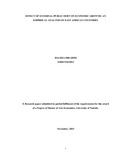Effect of External Public Debt on Economic Growth: an Empirical Analysis of East African Countries
Abstract
The aim of this study was to estimate the effect of external public debt on economic growth in four East African countries. These included Kenya, Tanzania, Uganda, and Rwanda. The study also analyzed the risk and costs associated with public debt in the countries. The study used panel data for the period 1981 to 2014. The data was analyzed using the fixed effect and the random effects model estimation techniques. The study found that external debt had a negative effect on economic growth in East African Countries. Domestic debt, on the other hand, had no significant effect on economic growth. Additionally, capital stock had a positive relationship with economic growth. However, macroeconomic factors such as real interest rate, inflation rate, and exchange rate did not have a significant effect on economic growth. The risk-cost analysis showed that EAC countries face exchange rate risks when borrowing. Specifically, a depreciation of local currencies led to an increase in public debt. In light of these findings, EAC countries should adopt an optimal balance between external and domestic debt to ensure sustainable economic growth. They should also implement measures to stabilize their currencies to avoid an increase in debt burden due to exchange rate depreciation.
Publisher
University of Nairobi

